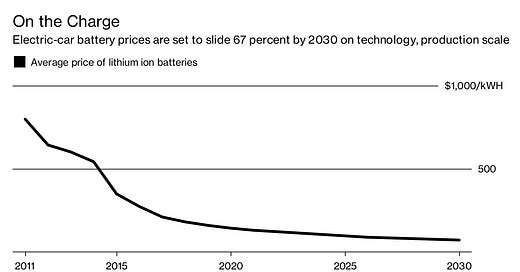How Much Has the Cost of Electric Vehicles Fallen in Recent Years?
There have been significant reductions in EV costs over recent years. Here are some of the reasons; from plummeting battery prices to lower retail and used EV prices
The transition to electric vehicles (EVs) is a crucial part of the global strategy to reduce carbon emissions and combat climate change. In the UK, this shift is being driven by ambitious government targets and a growing awareness of the environmental benefits of EVs. However, one of the key factors influencing the rate of EV adoption is cost. This article explores the significant reductions in the cost of electric vehicles over recent years, making them an increasingly affordable option for many consumers.
1. Battery Prices are Plummeting
The lithium-ion battery is the heart of an electric vehicle. It's the most expensive component, accounting for a significant portion of the overall cost of an EV. Therefore, the cost trajectory of lithium-ion batteries has a direct impact on the affordability of electric vehicles.
Over the past decade, the cost of lithium-ion batteries has seen a dramatic decrease. In 2010, the average cost of a lithium-ion battery pack was over $1,100 per kilowatt-hour (kWh). By 2023, this cost had fallen to just $137 per kWh, representing an 87% decrease(1). This dramatic drop in battery prices is a result of several factors.
Firstly, economies of scale have played a significant role. As production volumes have increased, manufacturers have been able to reduce costs through efficiencies in the manufacturing process. Secondly, technological improvements have led to more efficient and cost-effective battery designs. These advancements have not only reduced costs but also improved the performance and lifespan of lithium-ion batteries, further enhancing the value proposition of electric vehicles.
2. EVs Retail Prices Reflect Lower Production Costs
The decrease in battery prices has had a direct impact on the retail prices of EVs. As the most expensive component of an EV, reductions in battery costs have translated into lower production costs for electric vehicles, which manufacturers have passed on to consumers in the form of lower retail prices.
For instance, the average price of a new EV in the UK has dropped from around £42,000 in 2013 to approximately £35,000 in 2023(2). This represents a decrease of about 17% over a decade.
Moreover, the price gap between EVs and their petrol or diesel counterparts has also been narrowing. As the costs of producing EVs continue to fall, we can expect this trend to continue, making EVs an increasingly affordable option for many consumers.
3. Used EVs Also Seeing Price Drops
The trend of decreasing prices is not limited to new EVs. The used EV market has also seen significant price reductions. This is important because the used car market plays a crucial role in vehicle ownership for many people. Lower prices in the used car market make EVs accessible to a broader range of consumers, thereby accelerating the transition to electric mobility.
For instance, used EV prices in the UK have fallen by 21.2% over the first four months of 2023(3). This trend is expected to continue as more used EVs enter the market, further driving down prices.
Conclusion
The cost reductions in the EV market are a promising sign for the future of electric mobility. The plummeting prices of lithium-ion batteries, coupled with the decreasing retail prices of new and used EVs, are making electric vehicles more accessible to a wider range of consumers. This trend is not only beneficial for consumers but also crucial for achieving our climate goals.
As technology continues to advance and economies of scale further reduce production costs, we can expect the cost of EVs to continue to fall. This optimistic outlook suggests that the mainstream integration of electric vehicles is not a distant dream but an imminent reality.





🤣🤣🤣🤣🤣🤣🤣🤣🤣🤣🤣🤣🤣🤣